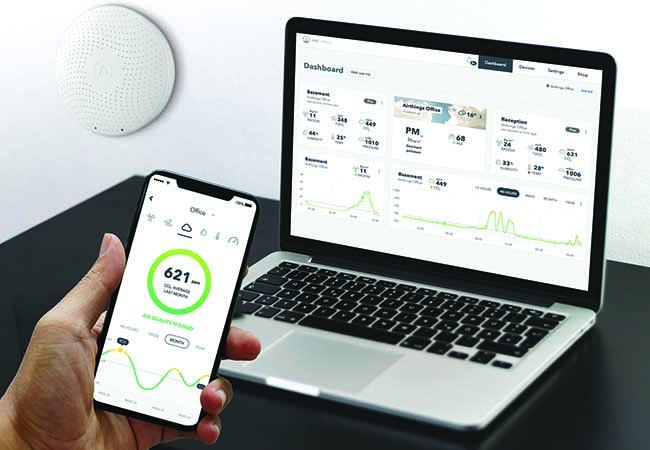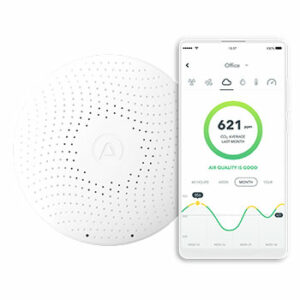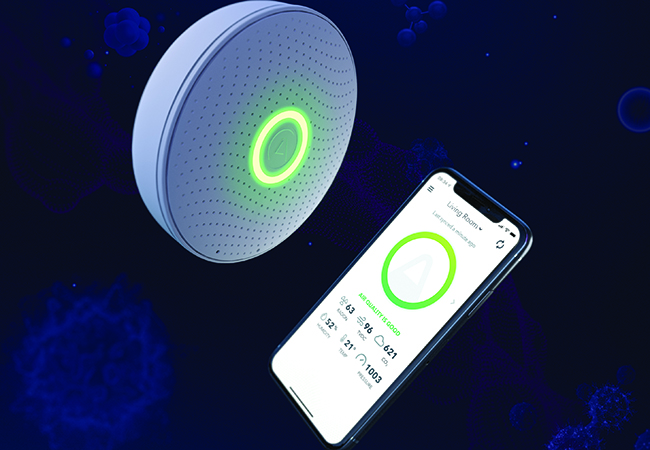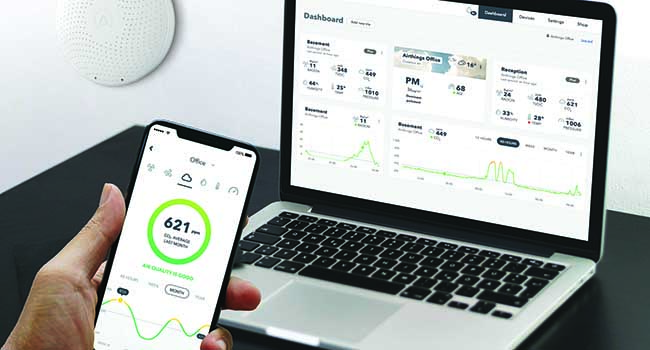
Wave Plus can provide air quality results through the companion app. Simply pair it with your smartphone or tablet and it will keep track of the six factors measured
 You may think you’re doing your duty to help flatten the COVID-19 infection curve but staying home may expose your family to different types of health risks.
You may think you’re doing your duty to help flatten the COVID-19 infection curve but staying home may expose your family to different types of health risks.
No, the culprit isn’t bacteria or a virus. It’s the quality of the air we breathe in our homes and the contaminants lurking within. It may be an excess of carbon dioxide (CO2) impairing restfulness. Perhaps it’s volatile organic compounds (VOCs) from cooking, paints and cosmetics causing nose and throat irritations. Or it could also be something as simple as an imbalance of air pressure or humidity causing discomfort.
It could even be radon gas, the second leading cause of lung cancer after smoking, according to Health Canada. Smokers are at even higher risk.
Radon is everywhere. It doesn’t matter where you live – a new house or a century old – every home has some level of radon and that level determines the health hazard.
Radon is produced naturally by the decomposition of uranium in the soil under your home. This invisible gas seeps into your home due to the differences in indoor and outdoor air pressure. It sneaks in through openings like floor drains and sump pumps, foundation and floor cracks, and tiny gaps around pipes entering the home.
As a result, it’s more likely to be concentrated in basements and crawl spaces than upper areas of your home.
Don’t hit the panic button. Unlike deadly carbon monoxide or fumes from a fire that attack quickly, radon is only hazardous over time – and you can do something about it.
A professional can test for radon levels and other air pollutants in your home, or you can do it yourself with a detection system like Wave Plus by Airthings. Some public libraries even have radon detection kits.
Wave Plus is a smart indoor air quality plus radon detector that looks like and installs just as easily as a smoke detector. It has six sensors measuring radon, VOCs, CO2, humidity, air pressure and temperature. You can see your initial test results within an hour by simply waving your hand across its face.
If measurements are within acceptable levels, the glow ring will turn green like a traffic light. Yellow says caution and red indicates you’re in the danger zone.

The Wave Plus has six sensors measuring radon, VOCs, CO2, humidity, air pressure and temperature
According to Health Canada, the acceptable standard for radon is 200 Bq/m3 (becquerels per cubic metre). One becquerel equals one radon atom disintegration per second.
Wave Plus can provide results through the companion app. Simply pair it with your smartphone or tablet and it will keep track of the six factors measured.
You can plot a graph that covers the previous 48 hours, a week, month or year.
The app is designed to track multiple units in your home.
You can receive notifications though the app, as well as sync information when you’re within Bluetooth range. You can also receive email and audio alerts when the radon levels become too high. An optional $99 hub is available to further tie all your devices together and monitor your home remotely 24/7.
Since radon and other levels are always fluctuating, the longer the test period, the more accurate your results. Health Canada recommends that homes be tested for radon for a minimum of three months, ideally during the heating season when windows are typically closed.
Airthings also has a web-based dashboard to help with your tracking. It offers a more detailed look over time. You can also create customized reports and download your data should you need further analysis.
Should levels consistently read high, call in a professional to determine what remedial action is needed. There could also be other contaminants like mold also lurking behind the walls – but there are other detection devices for that.
Wave Plus comes with a magnetic plate that mounts on a wall with a single screw. The unit is powered by two standard AA batteries (included) that should last up to 18 months. It retails for $299.99 and you can find it BestBuy, Home Depot or Amazon. Other models/configurations are also available.
You can find more comprehensive information on radon and other pollutants, their risks and what you can do to keep your family safe by visiting Health Canada.

Wave Plus is a smart indoor air quality plus radon detector that looks like and installs just as easily as a smoke detector
Troy Media columnist Greg Gazin, also known as the Gadget Guy and Gadget Greg, is a syndicated veteran tech columnist, communication, leadership and technology speaker, facilitator, blogger, podcaster and author. Reach him @gadgetgreg or at GadgetGuy.ca.
For interview requests, click here. You must be a Troy Media Marketplace media subscriber to access our Sourcebook.
The views, opinions and positions expressed by columnists and contributors are the author’s alone. They do not inherently or expressly reflect the views, opinions and/or positions of our publication.

